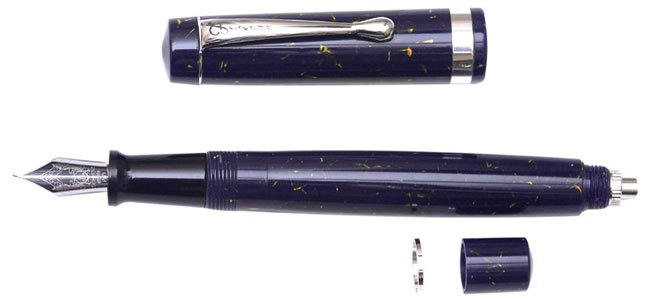|
A Writer’s Pen designed by Richard Binder for FILCAO of Settimo Torinese
Columbia, the Gem of the Ocean is a modern pen with its roots in the past.
This new pen is the result of over one year of design, producing prototype
models for testing and constitutes a unique example of transatlantic cooperation.
FILCAO's owner asked Richard Binder to design a “writer's pen”,
a pen that would be inspired by the great vintage designs of yesteryear and offer
the writing characteristics of the great classic pens. The final creation had
to be cost effective to produce a reasonably priced product for a wide audience
of writing instrument enthusiasts and have the appearance of a classic and stylish
writing instrument.
Giovanni Abrate, the U.S. distributor for FILCAO writing instruments released
the following statement to announce the arrival of the FILCAO Columbia –
The Gem of the Ocean.
“The result is stunning…I have just handled the first production
samples and the quality is outstanding.”
The pens are made in a specially produced high luster celluloid (acetate) in
an exclusive FILCAO dark Lapis Blue pattern with golden speckle embedments. The
color is a dark blue, with faint antique yellow traces. It is similar to the pattern
used in the Signum pens, but much darker, about the same as the 1920s Parker Lapis
Blue celluloid. I would say that the size and weight are very close to those of
a modern Parker Duofold International. The contoured barrel makes this pen a joy
to hold and the pen balances wonderfully both with cap posted and unposted. All
the trim is Rhodium plated and the wide cap ring is Sterling Silver and can be
engraved. The cap ring is swaged into place (again, a technique used by vintage
pens).

The high strength steel clip ring is fashioned with the appearance of the
classic 1930’s Italian smooth taper shape. The large clips are Rhodium plated
and carry the FILCAO name. The cap was designed in the fashion of vintage pens.
Screwing the cap on seals the nib, as the flared lip of the section goes to rest
against the inner cap. The cap has one vent hole, just outside the sealed area,
to prevent any vacuum effects when uncapping the pen.
The Columbia is a classic button filler and Richard's design has captured
the lines and balance of the classic pens of the past. The steel nib is sweet
and smooth and is decorated with the FILCAO logo emblem. The Columbia nib is different
from the nib used in the Leader. The Leader nib is made by Bock and is larger
than the Columbia nib, which is made by Schmidt. The Columbia nib is a superb
steel unit from Schmidt, sporting their newly developed “ball tip”.
Smooth as silk! The nib is not a flex nib, but is also not a nail. I can say that
I have no other pen that is as smooth as Columbia out of the box. This is the
same writing "engine" that has made the Tukano rightly famous for it’s
widely favored writing characteristics.
The section is specially machined out of a block of metacrylate and is shaped
as you would find with vintage pens from the 1930’s. This provides a smooth
grip to the edge with no trim ring. The section, at its flared end is 1 cm in
diameter or approximately 3/8"

This is a pen designed along vintage lines. It is made like a vintage pen,
and it handles like one. The barrel is shaped ergonomically and the pen balances
beautifully both when the cap is posted and also unposted. The filler is operated
via a button located under the blind cap. The filler mechanism is the same as
the Parker Duofold from the 1930s. The filler button is rhodium plated and installed
using a specially designed threaded collar.
There are no brass liners. The inner cap screws into the cap and seals against
the section. There are breather holes outside the sealed area, as in vintage pens.
The cap is fairly thick and has a solid feel, and we think the balance of the
pen is superb. The sterling cap band is swaged into position (made oversize and
then pressed between rollers that shrink it into the groove made to receive it);
this also a vintage feature. Some modern makers machine the cap in two pieces
and screw the pieces together with the band between.
Giovanni concluded his statement saying, “The writers have spoken, given
their opinions and FILCAO listened to Richard’s ideas and suggestions…and
they listened well.”
Richard Binder was caught while dashing between pen shows recently and finally
forced to take a break and eat lunch. Barbara, his wife with matching pen theme
vest, was pleased we finally caught them so she can see to it that Richard was
finally holding some carbohydrates in his hands instead of ebonite. While chewing
on his bacon, lettuce and tomato on toasted whole wheat “easy on the mayo”
sandwich we plied our questions about how he conceived his idea for this pen.
“The details are pretty simple. At last year's Atlanta pen show, Giovanni
and I got to talking about certain features of some FILCAO pens and why they were
good or bad, and we found that we pretty much agreed on all the significant points.
The sum of what we liked pointed to certain vintage pens. Never one to leave well
enough alone, I modestly said I'd like to design a real writer's pen for FILCAO,
to show them what we had been talking about.
Giovanni consulted with Mr. Francesco Grisolia, the owner of FILCAO, and the
word was “Yes!” they liked the ideas. I produced a design concept
with specifications for materials and size, Giovanni showed it to Mr. Grisolia,
and we were off to the races. The people at FILCAO did a tremendous job in developing
the pen to be suitable for production and true to the concept.
FILCAO also conducted extensive testing of pre-production samples to be sure
the pen would have the quality that we all wanted. The result is as you see it.
I'm very pleased with the results, and I am honored to have been given the opportunity
to be involved.”
At present, the only nib available is the same Medium/Fine that is on the
Filcao Tukano. Giovanni is working with the factory to have them produce larger
size nibs. The nib and feed can be removed by unscrewing, similar to a Pelikan
nib. We are trying to procure F and B nibs to offer as alternatives.
The initial production of the Columbia will be 400 pens. If the pen is successful,
FILCAO will schedule the Columbia for continuous production.
The FILCAO Columbia carries a 12 months warranty.
If the buyer returns the enclosed registration card, it will be recorded as the
original buyer and will have the distributor's stamp and date on it. Said Richard…”I
can stub this nib very nicely for you if that's acceptable.”
Richard Binder, located in Nashua, NH specializes in nib repairs, custom nib
grinding and fountain pen restoration.

www.richardspens.com
|